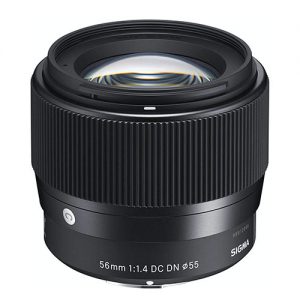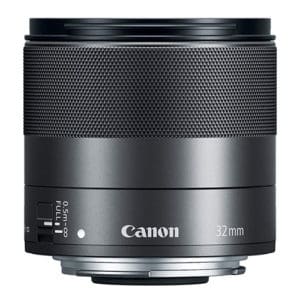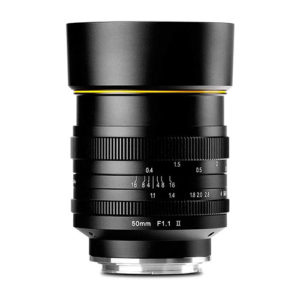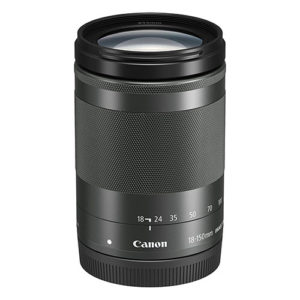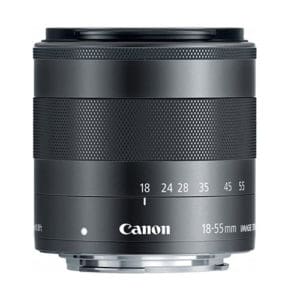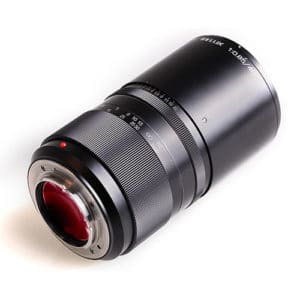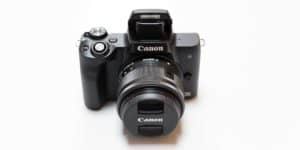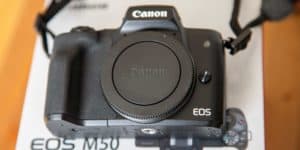The Canon EOS M50 is a great little camera that is well suited to shooting a variety of photographic styles and genres.
Unfortunately, though, there is still only a limited range of M-mount lenses available from Canon.
On top of which, the M-series suffers from several notable gaps in its coverage; both in terms of focal length and light gathering abilities.
The lack of native Canon options will be particularly apparent to anyone who shoots portraits.
Typically portrait photographers value short-to-mid range telephoto lenses with fast maximum apertures; ideal for putting greater emphasis on the subject by throwing the background out of focus.
But Canon provides extremely thin pickings in this area.
Luckily a handful of third-party manufacturers have stepped in to provide M50 owners with a number of excellent quality, and often quite affordable, lenses that are very well suited to shooting portraiture.
In this guide I take a look at seven of the best portrait lenses for Canon M50 currently available, including third-party offerings alongside those few Canon lenses that make the grade.
I then go on to look more closely at what makes a great portrait lens for the Canon M50, arming you with the necessary info to decide for yourself which of the suggestions I’ve made best suits your particular needs and budget.
Those searching for a great all-round portrait lens for the M50 need look no further than Sigma’s excellent 56mm f/1.4.
Offering a field of view equivalent to an 85mm lens on full frame, and featuring a fast maximum aperture for throwing backgrounds out of focus, it simply ticks all the main boxes as a portrait lens.
Both autofocus and manual (by-wire) focusing work brilliantly, and the lens comes with a very smooth rubberized focus ring that is a real pleasure to use.
While the lens is quite small, it features a very solid metal build that inspires confidence that it will still be with you for many years to come.
Used wide-open at f/1.4, images are very sharp and contrasty at the center of the frame, with just a touch of softness towards the extreme corners.
Shut the lens down to f/2, though, and the edges get considerably better and the center becomes even sharper still. Excellent stuff!
The lens remains sharp though to f/8, after which things begin to move back in the direction of softness due to diffraction.
However, as a portrait photographer, you’re unlikely to invest in this beautifully sharp and fast lens only to go using it stopped down anyway.
The Sigma 55mmm produces little or no flare, even when shooting right into the light.
But on the downside, there’s quite noticeable pincushion distortion and vignetting when it’s used wide-open. Do keep in mind, though, that your camera will automatically correct for most of this anyway when shooting JPEGs, and if shooting RAW you can easily do the same yourself using software.
In contrast to Canon’s very limited offerings in this focal range, the Sigma 56mm’s fast maximum aperture provides excellent opportunities for creating a very shallow depth-of-field – which after all is what most people are looking for in a portrait lens.
Meanwhile, it also produces very nice bokeh indeed; guaranteeing that out of focus areas are also a pleasure on the eye.
Finally, while not dirt cheap, pricing is perfectly reasonable for a lens of this quality.
As a result I have no reservations about putting the Sigma 56mm f/1.4 right at the top of my list of the best portrait lenses for the EOS M50.
Let’s be totally clear; Canon’s EF-M 32mm f/1.4 is not a “portrait lens” in the traditional sense of the term. Simply because it offers a field of view – equivalent to 51mm on full frame – that’s considerably wider than is normally meant by this phrase.
But can you make good portraits with it? You bet!
True, you won’t be shooting any tight headshots with this piece of glass.
But for full length portraits, and more environmental shots where you want to show some context beyond the subject, it’s really a very beautiful lens.

Images are supremely crisp and detailed, from edge to edge. Even when shooting wide open.
And for portraits you will want to do just that, as the f/1.4 aperture makes for a nicely shallow depth-of-field and highly attractive bokeh.
Less positively, images produced with the 32mm f/1.4 display a noticeable degree of barrel distortion.
However, as this problem is only really evident when shooting rigid verticals and horizontals, it’s rarely a major concern for portrait photographers.
Meanwhile, the fact that most portrait photographers seem to favor adding a vignette effect to their images at the editing stage means that the natural vignetting created by this lens might even be viewed as an advantage by some.
Focusing works well, and there’s a focus limiter switch that can be very handy for avoiding “focus searching” between background and foreground.
Note, however, that there’s no image stabilization with this lens.
Still, as the EOS M50 already provides peace of mind in this department, the lack of IS is neither here nor there really. In any case, IS is rarely included in lenses of this focal length anyway, as it’s simply not all that necessary.
Build quality is excellent (metal, rather than plastics).
In fact the only real downside to this lens is that the high overall attention to quality and detail is reflected in a comparatively high retail price.
It’s always nice to be able to include a fun, cheap option in any gear guide. Especially when the lens in question is also pretty good optically.
And the Kamlan 50mm f/1.1 MK 2 is just such a lens.
Equivalent to 75mm on full frame, the Kamlan is a little short of what most people would consider to be a classic portrait lens.
That doesn’t stop it from throwing the background nicely out of focus, though, as it comes with an extremely fast maximum aperture.
While the lens features 11 iris blades, unfortunately they are of the straight rather than rounded variety.
Despite this, though, bokeh is excellent.
Image quality is more of a mixed bag.
Wide open, the edges of the frame look pretty terrible, but thankfully the center is fairly sharp.
And by the time you get to f/2, the middle of the lens actually starts to draw close to the Sigma 56mm in terms of sharpness. The corners don’t get a whole lot better though, even when stopping down.
In terms of distortion and vignetting, the Kamlan is actually better than the Sigma; displaying very little of either (although keep in mind that, if you do go for the Sigma, those are problems that are easy to fix in post). It must be said, though, that there’s really a lot of flare with this lens, so a lens hood is a must.
Build quality is very good; heavy metal all the way.
And while there’s no autofocus, manual focus is very smooth and the focus ring has a long range, making precision focusing a breeze.
Aperture control, too, is all manual.
All in all, this is a good little product. Go for the Kamlan 50mm f/1.1 MK 2 if you’re on a budget but want a lens that will allow you to create characteristic shallow depth-of-field portraits with great bokeh.
More interested in supreme image quality than arty defocussed effects? Then spend a little more; while the new Kamlan 50mm is actually not bad at all in this department, there are nonetheless optically superior lenses available (see above).
Note that the MK II version of this lens displays much better contrast and sharpness than you got with the original release.
In fact, while I consider the MK II to be a serious option for a certain type of portrait photographer, I would avoid the MK I entirely.
For such a minimal difference in price, but a very noticeable difference in image quality, it’s really not worth skimping here.
While clearly not a dedicated portrait lens – this thing basically covers every common focal length imaginable – Canon’s 18-150mm f/3.5-6.3 zoom will nonetheless get you to any conceivable portrait photography destination you might wish to visit.
From wider environmental portraits, through classic portrait lens territory, and on to very tightly cropped headshots.
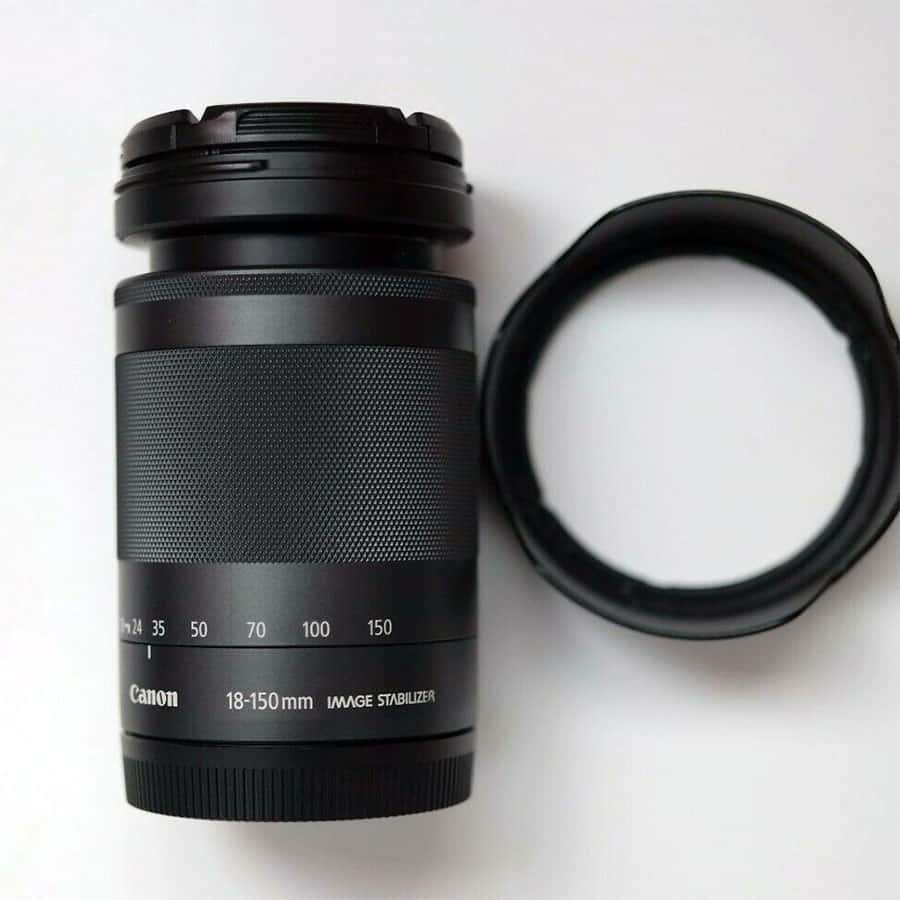
Of course, with a maximum aperture that starts at f/3.5 and then drops as far as f/6.3 at the longer end of the zoom range, it’s no bokehlicious dream machine.
But by the time you’ve arrived at the more portrait-appropriate zoom settings, most backgrounds will have been reduced to an unrecognizable blur anyway – even with the aperture stopped down.
And it must be said that shutting down the aperture a couple of stops results in some rather excellent quality images.
To be sure, sharpness is pretty good even wide open, but at slightly smaller apertures this thing truly begins to shine.
Meanwhile, the only optical defects worth dwelling on are barrel distortion and vignetting.
But, firstly, these problems are not typically of great concern to most portrait photographers.
And, secondly, they only really become noticeable at wider zoom settings – where the average portrait photographer is unlikely to spend much of their time shooting anyway.
Nonetheless, I feel it’s worth mentioning these issues, simply because anyone who chooses to purchase a lens with as wide a zoom range as this clearly also has other photographic uses in mind beyond solely shooting portraits.
And that’s really the 18-150mm’s main strength; allowing photographers to quickly switch between styles and genres without the need to carry multiple lenses around with them.
While your M50 body comes with image stabilization already, longer lenses are particularly prone to producing camera shake, so the inclusion of in-lens IS here is a welcome addition.
Here’s another option that is not a “portrait lens” as such, and yet warrants inclusion in this guide all the same.
Canon’s 18-55mm f/3.5-5.6 is an affordable zoom lens that, in addition to wider focal lengths, also covers the shorter telephoto range that is highly suitable for portraiture.
Strongly built from metal (the barrel and mount) and high grade plastic (some of the internal parts), the 18-55mm is a reliable yet affordable entry-level option for portrait photography.
Although image stabilization won’t be a priority for MM50 users – the camera itself already offers reliable IS – the addition of this feature is certainly not to be held against the lens. Indeed, the more the merrier.
More interesting from our point of view, though, is image quality; the 18-55mm produces very sharp and detailed images, with only a slight degree of barrel distortion and some flare when pointed into the light.
AF works very well, homing in on its target quickly and accurately. Meanwhile, those who prefer manual control in order to ensure that focus is tightly locked on their subject’s eyes will find the (by-wire) manual focus ring a pleasure to use.
Where this lens loses points, however, is on maximum aperture. Clearly f/3.5 is already rather slow for portraiture as it is.
On top of which you only benefit from this aperture at wider zoom settings, which aren’t really appropriate for portraits anyway.
Instead, by the time you’ve zoomed through to a more suitable focal length for shooting people, maximum aperture has dropped to a rather lame f/5.6. Meaning that more of the background is likely to be in focus than you might have hoped.
To be clear, depth-of-field also depends on several other factors beyond aperture. And assuming those other conditions are right, it’s totally possible to produce good portraits at f/5.6. But let’s just say that in most circumstances this would not be the average portrait photographer’s first choice of aperture.
So, yes, while the 18-55mm is a legitimate option for portraits, it is not without a degree of compromise. By way of compensation, though, you do get a lens that is capable of shooting a lot more than just portraiture.
As a result, it’s a good option for those photographers for whom portraiture is only one of several favored genres. Throw the 18-55mm in your bag and you’re ready for everything from portraits to landscapes and whatever else the day might bring.
Here’s an unusual item; the Handevision/Kipon Ibelux 40mm f/0.85.
Not only does it stand out for being one of – if not the – fastest commercially available camera lens in the world, but it also costs an absolute fortune compared to pretty much any other EOS-M lens currently on the market.
What’s more, its image quality is fairly unusual. But more on that in a second.
At 40mm, this lens is on the shorter end of the portrait range; in fact, equivalent to 64mm on full frame, it’s not far off a standard lens.
Yet many photographers will find this focal length a pleasure to use for environmental portraits or August Sander-style full-body straight-ups.
It’s an absolute tank of a lens, and made from what feels like solid chunks of metal and glass.
While this is reassuring, it makes for an extremely big and heavy lens that doesn’t balance particularly well on the dinky little M50 body.
As with a lot of the third party glass available for the M50, the Ibelux is manual focus only.
If you’re accustomed to “by-wire” manual focus systems, though, you will likely find the Ibelux an eye-opener, as it features a very smooth and responsive manual focus ring that is a real pleasure to use when compared with the simulated manual operation found on many M-mount lenses.
You may need to use focus-assist when shooting wide open, though, as the depth-of-field produced by this lens at f/0.85 is absurdly shallow.
Meaning that even a very slight error in focusing can result in a badly blurred image.
However, this makes the lens particularly suitable for portraiture – at least of a more artistic kind – where you might want to get just the eyes sharply focused while the rest of the image falls off to a soft and blurry background.
And blurred it will be, as the Ibelux 40mm really struggles to produce images that are sharp at the edges.
To be clear, it’s very sharp in the center of the frame, even when used wide open. But forget about getting any resolution in the corners until you’ve closed the diaphragm down several stops.
The lens also suffers from a whole host of other quirky optical defects. Most notably, some very strong color fringing at f/0.85. However this is pretty much gone by f/2.
The lens also doesn’t produce great contrast. And there’s some barrel distortion and plenty of vignetting when wide open, too.
These are all issues that would be of considerable concern to most photographers. Portrait photographers are something of an oddity however.
Ninety-nine percent of the time we’re going to place our subject at the center of the frame. And as long as a lens displays good sharpness in this crucial area of the image, many of us will be willing to forgive all kinds of optical disasters elsewhere.
In fact, in some cases, extra blur towards the edges will be welcomed with open arms, helping as it does to draw the viewer’s attention towards the subject at the center.
And here that goal is aided by the fact that the Ibelux produces very smooth yet characteristic bokeh due to ten circular iris blades.
So, while landscape photographers will run a mile from this thing, for portraiture it offers some undeniable charms. Just keep in mind that the Ibelux 40mm is more a lens for adding interesting character to portraits than it is for capturing images of the world with neutral precision or accuracy.
Just don’t point this lens in the direction of a light source, though, as the flare it produces is probably the most extreme I’ve ever seen.
And not in a particularly good way either (unless you like the idea of phantom rainbow-colored jelly fish floating through your photos!).
Finally, for all its eccentricities, the Ibelux 40mm does at least come with an EF-M mount, so no adapter is required when using it with the M50.
Choosing the right lens for your portait photography with the EOS M50
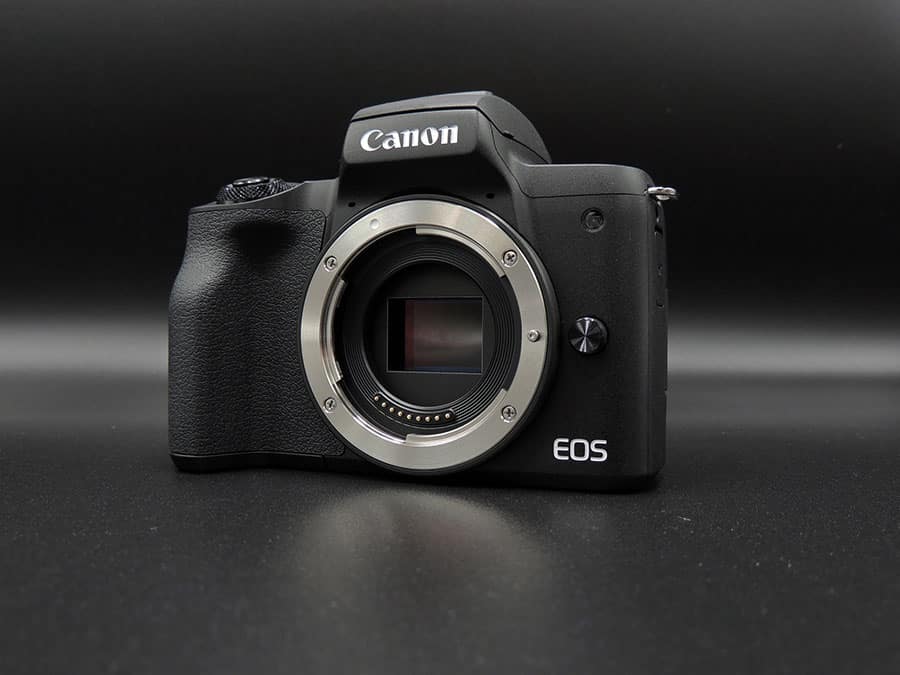
Maximum Aperture
For most portrait photographers, a fast maximum aperture will be way up at the top of their list of priorities when choosing a lens.
Not only does a wide diaphragm opening let in more light – allowing you to continue shooting handheld in the beautifully soft glow of the blue hour – but it also makes for a shallower depth-of-field.
This latter consideration is especially important in portrait photography, as it helps to create a greater degree of separation between subject and background.
Sadly this is where Canon has, for the most part, let M50 users down.
There are very few lenses in the native M-mount line that offer a fast maximum aperture.
Of these, precisely zero fall within the focal range generally considered most appropriate for portraiture.
The closest we can get using a native Canon lens is the 32mm f/1.4: essentially a standard lens, and therefore not appropriate for shooting tight headshots.
To be clear, though, it is a great lens. And is well-suited to a certain type of portrait. It’s just not a “portrait lens” as such.
Thankfully though, a number of Canon’s competitors have come to the rescue with a variety of slightly longer prime lenses featuring beautifully fast maximum apertures.
Unless you have some particular reason for wanting to stick with native Canon glass, or need a portrait lens that will also double up for other uses, these third-party offerings will usually be your best bet.
Bokeh

Strictly speaking, bokeh refers to the quality of out of focus areas of an image, not the degree to which those areas are defocussed.
Clearly, though, there will not be much in the way of bokeh to speak of if the lens in question isn’t capable of throwing the background out of focus in the first place.
And as we’ve just noted above, the majority of Canon’s M-mount lenses struggle to do precisely this.
Again, then, if bokeh is your thing, you’ll probably want to avoid most of Canon’s own offerings here and head directly for faster options from Sigma and Viltrox etc.
Nonetheless, once you’ve achieved a suitable degree of background blur for portraiture, there remains the question of precisely what that blur looks like.
This is the real issue of bokeh.
Some lenses render out of focus areas of the image smoothly, with soft transitions between one defocused object and another.
They may also show background lights as nicely rounded “bokeh balls.” While bokeh is subjective to some degree, most people would agree that these are the qualities of “good” bokeh.
Conversely, some lenses render background information in a busy or fussy manner.
Edges show messy details or double-imagery.
Bokeh balls are more elliptical than circular, and they may even be angular rather than smoothly rounded.
Most people would find bokeh of this kind somewhat distracting, and therefore inferior.
The average portrait photograph consists of two main elements; a subject, and a background.
We could abstract this statement slightly to say that a portrait consists of a sharply focused area, and the rest is bokeh.
Put like this, it’s clear that bokeh is an important issue for portrait photographers.
Be sure to take a close look at the way in which any lens you are considering purchasing for portraiture renders out of focus areas of the image.
Focusing
Given that the depth-of-field of portraits is often so narrow, it’s hardly surprising that focus can make or break a portrait.
Just as in real life, when we look at an image of a person, our eyes meet theirs.
In a portrait it can be highly disturbing if we don’t find their eyes to be sharply focused.
Even half an inch of error – putting the point of focus on the subject’s temple, or nose, for instance – can be more than enough to ruin a shot.
Some photographers couldn’t imagine having to make do without autofocus.
For others, manual focussing in the only way to ensure precision.
There’s no right or wrong way to go about it.
But if you’re the kind of portrait photographer who spends a long time meticulously getting the position and pose just right, before slowly firing off a few frames and calling it a day, manual focus might be the best option for you.
On the other hand, if you take a more lively and candid approach to portraiture, shooting a continuous volley of images of your subject in motion, hoping that at least a few of these are sharply focused in the right place, then autofocus is probably going to be the best bet.
Particularly eye-AF.
It’s common for third party lenses for the Canon M50 to lack autofocus capabilities.
In some circumstances that’s fine.
And if manual focusing is your thing, then a fully manual lens of this kind will likely provide the most satisfying experience (in contrast, the “manual” settings offered by most AF M-mount lenses are just simulated manual control, and don’t provide the same degree of precision or satisfaction as a truly mechanical manual lens).
But because not everyone who shoots portraits wants to work manually, here I’ve also tried to provide some good AF lens options. So whatever your preference, there’s likely to be a lens for you in my list above.
Sharpness
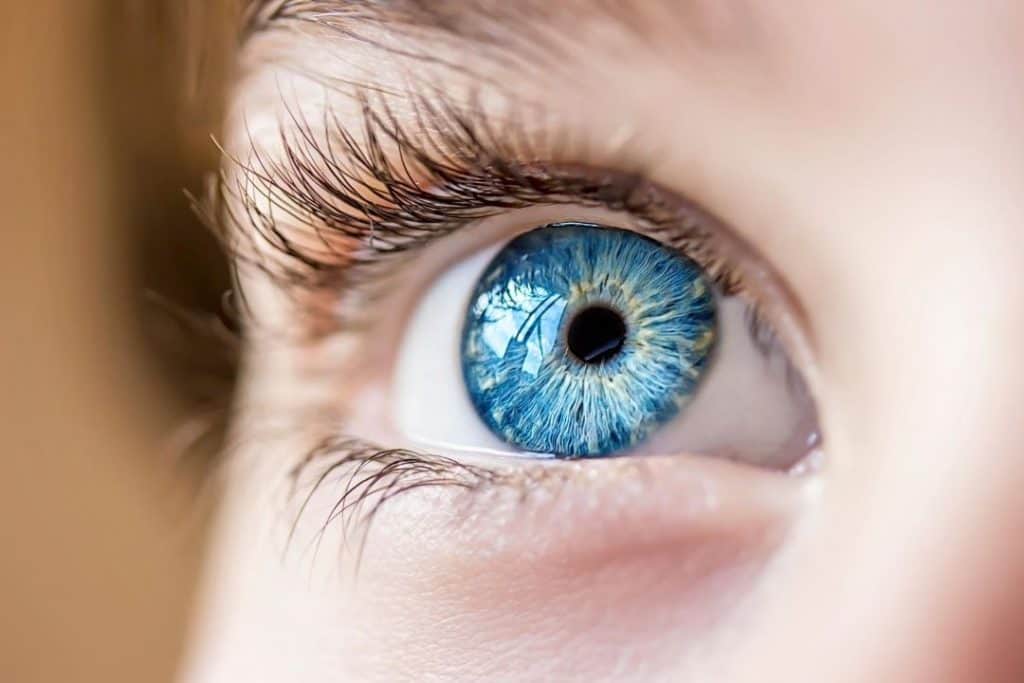
Having just spent several paragraphs stressing how important it is to nail focus, clearly it’s also important to use a lens that produces sharp images once it is correctly focused.
After all, focus speed and accuracy would become somewhat irrelevant in the case of a lens that can’t muster more than a mushy blur even when focused with absolute precision.
Certainly there’s nothing more satisfying than looking at a well shot portrait and finding your gaze returned by a beady eye that’s so sharply rendered as to be almost more real than real life.
Clearly, then, a good portrait lens is also a sharp lens.
Having said this, it’s important to realize that many lenses – even ones that are, on balance, optically very good – tend to produce less impressive results towards the edges of the frame. Especially when used at the kind of wide apertures favored by portrait photographers.
For many genres of photography this can be a real concern; when it comes to products, landscapes, architecture, and interiors, for example, the edges are likely to contain information that is only very slightly less important than at the center of the image.
Consequently, photographers working in these genres tend not to be very accepting of lenses that produce blurry corners.
But what’s in the corner of the average portrait photo?
Out of focus background most of the time, right? If these out of focus areas end up with an extra degree of blur due to poor optics, it’s hardly the end of the world. In fact, it could even bee seen as an advantage.
In short, when assessing a lens for portraiture, do pay attention to center sharpness.
But unless you can imagine yourself repeatedly placing your subjects on the edge of the frame, don’t worry too much about corner sharpness.
Focal Length
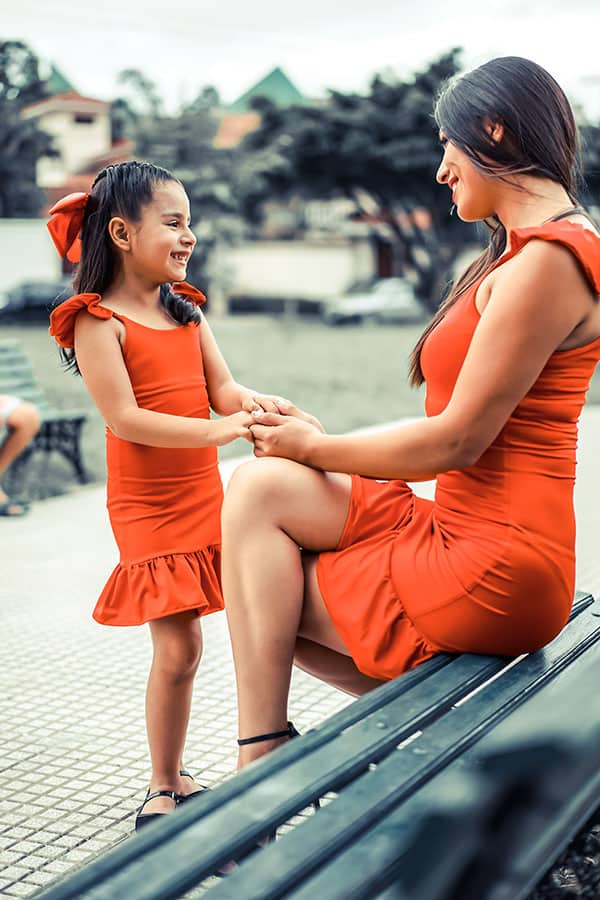
What is traditionally referred to as a portrait lens is one that falls somewhere between 80mm and 120mm on full frame – or thereabouts.
Which on the Canon M50 means a lens with a focal length of between, say, 50mm and 80mm or so.
The reason lenses within this range are considered ideal for portraiture is, firstly, that they permit the user to fill the frame with just the subject’s head and shoulders.
And, secondly, they tend to produce a fairly shallow depth-of-field; thus eliminating background distractions.
You can certainly shoot portraits with other focal length lenses, though.
Just keep in mind that a wider lens will be more appropriate for producing full length portraits, and will need to have a very fast maximum aperture if you are to achieve good separation between subject and background.
Meanwhile, a longer lens will have no trouble throwing the background out of focus – even at relatively slow aperture settings – but if it’s too long, you’d need to be standing at the opposite end of a football stadium to your subject in order to use it.
Primes vs Zooms
Zoom lenses have their clear advantages. They offer a wide range of focal lengths all in one, and can therefore be used to shoot many different kinds of portrait images; from environmental portraits through to tight headshots.
The problem is that, even at the best of times, zoom lenses tend to have slower maximum apertures than prime lenses.
And they often also come with slightly compromised optics. Meaning less sharp images.
And if the above is already true for most lens ranges, it is doubly so for the Canon M-series.
Meanwhile, prime lenses tend to have better optics, and faster maximum apertures.
As both of these qualities are highly valued for portraiture, you’ll usually find that the most popular portrait lenses are also prime lenses.
To be clear, some excellent quality zooms do exist; combining stunning image quality with relatively fast maximum apertures and the convenience of multiple focus lengths in a single lens.
They just tend to be very expensive.
On top of which, none of them come with a Canon M-mount.
Resources
Canon EOS M50 Mark II Specifications
| Body type | ||
|---|---|---|
| Body type | SLR-style mirrorless | |
| Sensor | ||
| Max resolution | 6000 x 4000 | |
| Image ratio w:h | 1:1, 4:3, 3:2, 16:9 | |
| Effective pixels | 24 megapixels | |
| Sensor photo detectors | 26 megapixels | |
| Sensor size | APS-C (22.3 x 14.9 mm) | |
| Sensor type | CMOS | |
| Processor | Digic 8 | |
| Image | ||
| ISO | Auto, 100-25600 (expands to 51200) | |
| Boosted ISO (maximum) | 51200 | |
| White balance presets | 7 | |
| Custom white balance | Yes | |
| Image stabilization | No | |
| Uncompressed format | RAW | |
| Optics & Focus | ||
| Autofocus |
| |
| Manual focus | Yes | |
| Number of focus points | 143 | |
| Lens mount | Canon EF-M | |
| Focal length multiplier | 1.6× | |
| Screen / viewfinder | ||
| Articulated LCD | Fully articulated | |
| Screen size | 3″ | |
| Screen dots | 1,040,000 | |
| Touch screen | Yes | |
| Screen type | TFT LCD | |
| Live view | Yes | |
| Viewfinder type | Electronic | |
| Viewfinder coverage | 100% | |
| Viewfinder resolution | 2,360,000 | |
| Photography features | ||
| Minimum shutter speed | 30 sec | |
| Maximum shutter speed | 1/4000 sec | |
| Aperture priority | Yes | |
| Shutter priority | Yes | |
| Manual exposure mode | Yes | |
| Built-in flash | Yes | |
| Flash range | 5.00 m (at ISO 100) | |
| External flash | Yes | |
| Flash modes | Evaluative (face priority), Evaluative, Average | |
| Continuous drive | 10.0 fps | |
| Self-timer | Yes (2 or 10 secs, custom) | |
| Metering modes |
| |
| Exposure compensation | ±3 (at 1/3 EV steps) | |
| AE Bracketing | ±2 (3 frames at 1/3 EV steps) | |
| Videography features | ||
| Format | MPEG-4, H.264 | |
| Modes |
| |
| Microphone | Stereo | |
| Speaker | Mono | |
| Storage | ||
| Storage types | SD/SDHC/SDXC slot (UHS-I compatible) | |
| Connectivity | ||
| USB | USB 2.0 (480 Mbit/sec) | |
| USB charging | No | |
| HDMI | Yes (micro-HDMI) | |
| Microphone port | Yes | |
| Headphone port | No | |
| Wireless | Built-In | |
| Wireless notes | 802.11b/g/n + Bluetooth | |
| Remote control | Yes (via smartphone) | |
| Physical | ||
| Environmentally sealed | No | |
| Battery | Battery Pack | |
| Battery description | LP-E12 lithium-ion battery & charger | |
| Battery Life (CIPA) | 305 | |
| Weight (inc. batteries) | 387 g (0.85 lb / 13.65 oz) | |
| Dimensions | 116 x 88 x 59 mm (4.57 x 3.46 x 2.32″) | |
| Other features | ||
| Orientation sensor | Yes | |
| Timelapse recording | Yes | |
| GPS | None | |
Final Thoughts
Although the EOS M50 is well suited to shooting portraits, Canon will need to add some faster prime lenses at longer focal lengths to its line-up if users aren’t going to continue to jump ship to third-party offerings.
To be clear, it is possible to shoot portraits using lenses in the existing Canon M-mount range. However, you just don’t get much choice or flexibility regarding the type of lens you can use (and therefore the kinds of portraits you can shoot).
For the time being at least, many of the best portrait lenses for the Canon M50 come from third-party brands.
Luckily, some of them also happen to be optically excellent products with very fast maximum apertures. They also tend to come at a price point equal to, and often even cheaper than, Canon’s offerings.
Hopefully you’ve found something in my list above that meets all your portrait photography needs.


